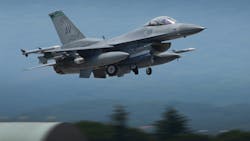Laser-Guided Rockets Take Out Cruise Missiles
Directed-energy weapons may have attracted the close attention and financing of Department of Defense (DoD) planners and allies, but conventional guided missiles will not be going away anytime soon—not if BAE Systems is involved. Weapons such as Advanced Precision Kill Weapon System (APKWS) laser-guided rockets incorporate laser guidance subsystems to track a target and provide efficient, effective munitions.
While APKWS rockets cannot match the almost zero damage to surrounding personnel and hardware compared to a directed energy weapon (DEW), they feature an extremely high hit rate in combat with low collateral damage. APKWS laser-guided rockets have been in use since 2012.
BAE Systems developed the 2.75-in.-diameter (70-mm-diameter) guided rockets as part of a contract from the U.S. Navy, with rockets also supplied to other branches of the U.S. military and foreign allies through the Foreign Military Sales (FMS) program. The company expects to deliver about 18,000 APKWS rockets in 2020. The rockets are qualified for use on Apache and Cobra helicopters and F-16 and F-18 fighter aircraft.
While drones or unmanned aerial vehicles (UAVs) are considered the fastest growing military threat, defenses are still needed for more traditional threats such as cruise missiles, and the APKWS rockets are viewed as viable candidates for cruise missile defense (CMD). Recent testing has shown them to be quite effective at tracking and destroying high-speed cruise missiles. The APKWS rockets represent much-less-expensive defenses against cruise missiles than the missiles commonly used for CMD, and they are ready for use long before the ready availability of DEWs. Because they are much smaller than CMD alternatives, many more APKWS rockets can be stored onboard a given aircraft.
About the Author
Jack Browne
Technical Contributor
Jack Browne, Technical Contributor, has worked in technical publishing for over 30 years. He managed the content and production of three technical journals while at the American Institute of Physics, including Medical Physics and the Journal of Vacuum Science & Technology. He has been a Publisher and Editor for Penton Media, started the firm’s Wireless Symposium & Exhibition trade show in 1993, and currently serves as Technical Contributor for that company's Microwaves & RF magazine. Browne, who holds a BS in Mathematics from City College of New York and BA degrees in English and Philosophy from Fordham University, is a member of the IEEE.

